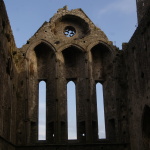Having absorbed the assumption that Christianity in Europe is moribund at worst and merely historical at best, I didn’t have high spiritual expectations for any of the churches we visited in Ireland. By the time we got to Galway, we had been to Christ Church Cathedral, the Rock of Cashel and Saint Multose, and tried and failed to see Glendalough Abbey (no parking spots open anywhere within 2 kilometres). All interesting from a historical standpoint, but we were kind of churched-out by the time we got to Galway and we almost didn’t go into St. Nicholas Collegiate Church.
St. Nicholas – a Church of Ireland parish; i.e., Irish Protestant similar to Church of England – is the largest medieval parish in Ireland that is still being used for worship. The oldest part of the church building dates to 1320, and Christopher Columbus is believed to have worshipped there in 1477. It features a large number of tombs, dating as far back as the 14th century, and some especially interesting and well-documented carvings around the doors, windows and archways. I was especially charmed by the “hound of heaven chasing the hare of the soul.”
But what surprised and attracted me had nothing to do with 14th-century stone carvings and everything to do with 21st-century activity. This was the first European church we’ve walked into that felt alive in the present to me. The first thing I noticed was that the church ladies were running a little café inside the sanctuary. Almost every seat was taken, mostly by locals, chatting and resting after shopping in Galway’s Saturday-morning open-air farm market. The second thing I noticed was the children’s art work – not hung in an entryway with the coats and umbrellas, but right in the sanctuary alongside the 16th-century baptismal font and the tomb of a 15th-century mayor. The third thing I noticed was flowers – absolutely everywhere in this church. On the altar. Beside the altar. Filling an ancient holy water stoup. In stands beside pillars. In pots on the floor. In front of the WWI memorial cross. In front of, in and around the little side chapel. Under the windows. The flowers, the artwork, and the friendliness of the café created such an atmosphere of joy that we just had to sit down and partake of the coffee and pastries for only 4 euros, and get into a nice chat with the rector’s wife. This charming lady, a liberal Christian after my own heart, described their Sunday School program and the concerts where they have to place extra chairs right on top of the floor tombs of medieval worthies, and their Harvest Festival donations to the food bank.
And I thought: Oh, wait, right. It isn’t about the buildings after all. They will all be ruins eventually, and there will still be no such thing as the “post Christian era” in any meaningful way. Our Lord lives in hearts, not in buildings, hearts like the ones so evident at St. Nicholas on that windy Galway Saturday, and like the ones in our own beloved home church, Zion Lutheran. I already knew that, of course. But the benefit of travel isn’t just that you come back with photos of the Eiffel Tower or the Cliffs of Moher. It’s that it shakes you out of your complacency, and causes you to question your own received wisdom. Sometimes you come away from that experience with a new wisdom, but sometimes what you come away with is a deeper, sweeter understanding of things that you knew all along.


